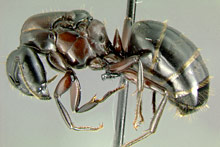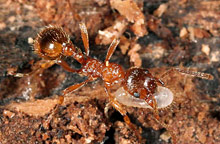- HOME
- » PEST SOLUTIONS
- » Ants
Ants
How to deal with ants
 |
|
Carpenter ant. Photo by Gary Alpert, Env. Health & Safety, Harvard U. |
 |
|
European imported fire ant. Photo by Gary Alpert, Env. Health & Safety, Harvard U. |
Do two things to keep these tiny cleaning ladies out. First, make it hard for them to get in. Use screens and door sweeps. Trim branches that touch the building. Seal holes in your siding (like where pipes go through the wall). Second, no free lunch. Keep the counters clean, the floors swept, spilled sweets cleaned up, food put away. Fix leaking pipes.
Meanwhile, keep an eye on bathroom and kitchen walls, the trim around doors and windows, and the wall near appliances that use water—you’re most likely to find carpenter ants there. But they’ll even colonize a leaky roof.
Got a problem? Learn which ant you have so you can take the right steps toward control. Identification is possibly the most important step in ant IPM—the kind of ant will determine whether you should focus efforts indoors or out and also what pesticides will work. These pests are picky! Ask your pest management professional or call your local Cooperative Extension office for help with ID. If you’ve got a magnifying glass and aren’t afraid to get up-close-and personal, compare your pest to the ants on the UC IPM Ant Management Guidelines and follow the instructions. Don’t use sprays inside. Baits are generally the pesticide formulation of choice for ant control.
What they look like
Brown, red, black, and everything in between, ants come in many colors and sizes. Wondering if you saw an ant or a subterranean termite? Ants have a narrow waist, giving them an hourglass figure. Termites don’t. Seen an ant with wings—or more likely, a kazillion of them? Now and then, males and new queens swarm off to start new colonies. If your ant has four wings of two different sizes, you’ve got an ant. Swarming termites have four long wings.
Where they live
Ants live in large colonies underground, in rotting wood, or in moist, protected places—under bricks or patio stones, for example. Carpenter ants are more neighborly. They’ll set up shop in your building if water or water-damaged wood is nearby.
What they do
Hard-working ants tirelessly clean up dead insects and dropped crumbs. The problem comes when they start cleaning your house too. Most will grab a crumb and head back outside to feed their friends, but carpenter ants prefer to build at the source and will excavate your walls to be near water.
Resources
Managing Ants with Baits (UC IPM)
How to Bug Proof Your Home (eXtension)
Sustainable Fire Ant Management (University of Florida Extension)
See results from the Northeastern IPM Center’s resources database
